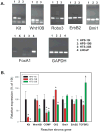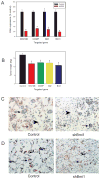Genes upregulated in prostate cancer reactive stroma promote prostate cancer progression in vivo
- PMID: 24150235
- PMCID: PMC3947312
- DOI: 10.1158/1078-0432.CCR-13-1184
Genes upregulated in prostate cancer reactive stroma promote prostate cancer progression in vivo
Abstract
Purpose: Marked reactive stroma formation is associated with poor outcome in clinically localized prostate cancer. We have previously identified genes with diverse functions that are upregulated in reactive stroma. This study tests the hypothesis that expression of these genes in stromal cells enhances prostate cancer growth in vivo.
Experimental design: The expression of reactive stroma genes in prostate stromal cell lines was evaluated by reverse transcriptase (RT)-PCR and qRT-PCR. Genes were knocked down using stable expression of short-hairpin RNAs (shRNA) and the impact on tumorigenesis assessed using the differential reactive stroma (DRS) system, in which prostate stromal cell lines are mixed with LNCaP prostate cancer cells and growth as subcutaneous xenografts assessed.
Results: Nine of 10 reactive stroma genes tested were expressed in one or more prostate stromal cell lines. Gene knockdown of c-Kit, Wnt10B, Bmi1, Gli2, or COMP all resulted in decreased tumorigenesis in the DRS model. In all tumors analyzed, angiogenesis was decreased and there were variable effects on proliferation and apoptosis in the LNCaP cells. Wnt10B has been associated with stem/progenitor cell phenotype in other tissue types. Using a RT-PCR array, we detected downregulation of multiple genes involved in stem/progenitor cell biology such as OCT4 and LIF as well as cytokines such as VEGFA, BDNF, and CSF2 in cells with Wnt10B knockdown.
Conclusions: These findings show that genes upregulated in prostate cancer-reactive stroma promote progression when expressed in prostate stromal cells. Moreover, these data indicate that the DRS model recapitulates key aspects of cancer cell/reactive stroma interactions in prostate cancer.
Conflict of interest statement
Figures






References
-
- Tuxhorn JA, Ayala GE, Rowley DR. Reactive stroma in prostate cancer progression. J Urol. 2001;166:2472–83. - PubMed
-
- Chung LW, Baseman A, Assikis V, Zhau HE. Molecular insights into prostate cancer progression: the missing link of tumor microenvironment. J Urol. 2005;173:10–20. - PubMed
-
- Ayala G, Tuxhorn JA, Wheeler TM, Frolov A, Scardino PT, Ohori M, et al. Reactive stroma as a predictor of biochemical-free recurrence in prostate cancer. Clin Cancer Res. 2003;9:4792–801. - PubMed
-
- Yanagisawa N, Li R, Rowley D, Liu H, Kadmon D, Miles BJ, et al. Reprint of: Stromogenic prostatic carcinoma pattern (carcinomas with reactive stromal grade 3) in needle biopsies predicts biochemical recurrence-free survival in patients after radical prostatectomy. Hum Pathol. 2008;39:282–91. - PubMed
Publication types
MeSH terms
Substances
Grants and funding
LinkOut - more resources
Full Text Sources
Other Literature Sources
Medical
Miscellaneous

